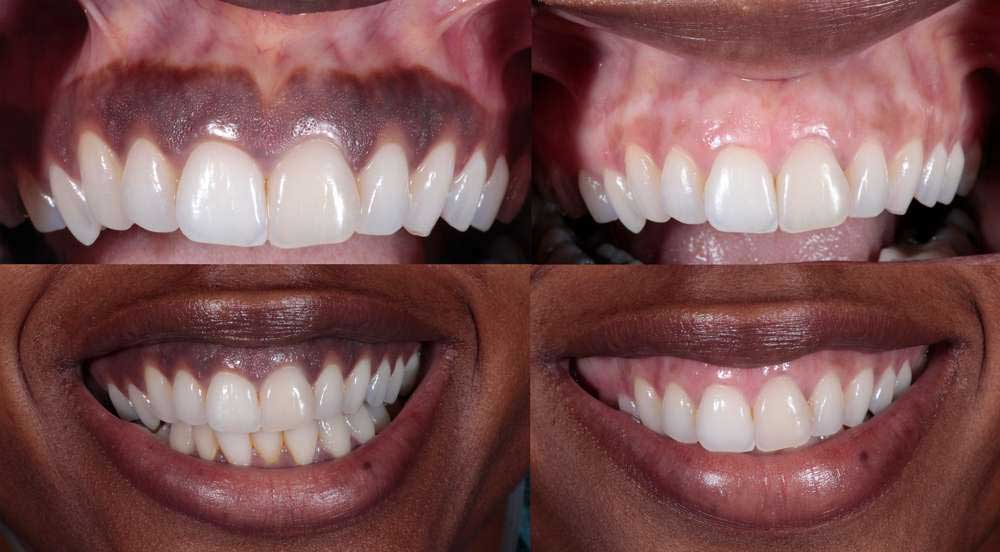Why Are My Gums Black? Causes, Treatments, and When to See a Dentist

Key points
- Sudden changes in the color, shape, or texture of your gums.
- A new black spot that appears suddenly.
- Pain, swelling, or bleeding accompanying the discoloration.
- Foul breath or a bad taste in your mouth that doesn't go away.
- Other symptoms throughout your body, such as fatigue or weight loss.
Noticing your gums are black or have dark spots can be alarming. While healthy gums are typically thought of as coral pink, their color can vary widely, just like skin tones. For many, dark gums are a completely normal and harmless trait. However, a sudden change in gum color can sometimes signal an underlying health issue that needs attention.
This comprehensive guide will walk you through the various causes of black gums, helping you distinguish between benign pigmentation and signs of a potential medical condition. We'll cover everything from natural variations and lifestyle factors to specific diseases and available treatments.
Why Are My Gums Black? Harmless vs. Concerning Causes
The reasons for black gums fall into two main categories: benign (harmless) pigmentation that doesn't require medical treatment, and pathological (disease-related) discoloration that does.
Harmless and Benign Causes of Black Gums
In most cases, dark gums are not a sign of poor health. Here are the most common benign causes:
Natural Melanin Pigmentation
Just as melanin determines the color of our skin and hair, it also influences the color of our gums. Individuals with more melanin, particularly those of African, Asian, and Hispanic descent, often have naturally dark brown or black gums. This is known as physiological pigmentation and is a normal genetic trait. If your gums have always been dark, there's no reason to worry.
The primary concern with naturally dark gums is that the pigmentation can sometimes make it harder to spot the early signs of gum disease, like redness and inflammation. This makes regular dental check-ups especially important.
 Image Source: CENTER for Advanced Periodontal & Implant Therapy
Image Source: CENTER for Advanced Periodontal & Implant Therapy
Smoker's Melanosis
Smoking and tobacco use can cause a condition called smoker's melanosis. Nicotine stimulates the body's pigment-producing cells (melanocytes) to create more melanin, leading to brown or black patches on the gums and the inside of the cheeks. This discoloration is directly linked to how much and how long a person has smoked. The good news is that these patches are benign and often fade or disappear completely within a few months to years after quitting smoking.
Medication Side Effects
Certain medications are known to cause hyperpigmentation in the mouth. The antibiotic minocycline, often used to treat acne, is a common culprit. Other drugs that can cause dark spots on the gums include some antimalarials, antipsychotics, and medications used in cancer therapy. If you notice a change in your gum color after starting a new medication, discuss it with your doctor.
Amalgam Tattoos
An amalgam tattoo is a small, flat, blue, gray, or black spot on the gums. It occurs when particles from a silver-colored (amalgam) dental filling accidentally get embedded in the soft tissue of your mouth during a dental procedure. These "tattoos" are completely harmless and don't require removal unless for cosmetic reasons or if there's uncertainty in the diagnosis.
Medical Conditions and Concerning Causes of Black Gums
While less common, a change in gum color can be a symptom of a health problem. It's crucial to see a dentist or doctor if you notice sudden darkening, especially if accompanied by other symptoms.
Acute Necrotizing Ulcerative Gingivitis (ANUG)
Also known as "trench mouth," ANUG is a severe and painful gum infection. It results from a rapid overgrowth of bacteria, often linked to stress, poor sleep, smoking, and poor oral hygiene. ANUG can cause a layer of dead tissue to build up on the gums, which appears gray or black. Other symptoms include severe gum pain, fever, foul breath, and bleeding. This condition requires immediate dental treatment, which usually involves a thorough cleaning and a course of antibiotics.
Addison's Disease
Addison's disease is a rare disorder affecting the adrenal glands, which don't produce enough essential hormones like cortisol and aldosterone. One of the tell-tale symptoms is hyperpigmentation, causing dark, blotchy patches on the gums and lips, as well as on the skin (often on knees, knuckles, and palm creases). Other symptoms include fatigue, muscle weakness, weight loss, and low blood pressure. If black gums are accompanied by these symptoms, it's vital to see a medical doctor.
Peutz-Jeghers Syndrome
This is a rare, inherited genetic condition that causes non-cancerous polyps to grow in the gastrointestinal tract and increases the risk for certain types of cancer. A key early sign is the appearance of dark blue or dark brown freckle-like spots on the mouth, lips, gums, and on the skin of the fingers and toes. These spots typically develop in childhood.
Oral Malignant Melanoma
In very rare instances, a new or changing black spot on the gums can be a sign of oral malignant melanoma, a type of oral cancer. It accounts for a very small percentage of all oral cancers. Because of its aggressive nature, any new, irregularly shaped, or changing pigmented lesion in the mouth should be evaluated by a dentist or specialist immediately, who may perform a biopsy to rule out cancer.
At-a-Glance: Distinguishing Benign from Pathological Discoloration
This table provides a quick summary to help differentiate the potential causes of black gums.
| Condition | Cause | Clinical Appearance | Treatment Focus |
|---|---|---|---|
| Benign Causes | |||
| Physiological Pigmentation | Increased melanin | Uniform brown to black patches, present long-term | None required; cosmetic options available |
| Smoker's Melanosis | Nicotine stimulation | Diffuse brown to black patches | Smoking cessation |
| Drug-Induced Pigmentation | Medications (e.g., minocycline) | Brown, black, or blue-gray discoloration | Discontinuation of medication (consult doctor) |
| Amalgam Tattoo | Amalgam filling particles in tissue | Single blue, gray, or black spot | None required |
| Concerning Causes | |||
| Addison's Disease | Adrenal insufficiency | Dark patches on gums, lips, and skin | Hormone replacement therapy |
| Peutz-Jeghers Syndrome | Genetic disorder | Dark blue or brown freckle-like spots | Monitoring for polyps and cancer |
| Oral Malignant Melanoma | Malignant melanocytes | New or changing pigmented lesion, irregular borders | Surgical excision, other cancer therapies |
| ANUG (Trench Mouth) | Bacterial infection | Gray or black layer of dead tissue on gums, pain, fever | Antibiotics, professional dental cleaning |
When to See a Doctor or Dentist
If your gums have always been dark, it's likely normal. However, you should schedule an appointment with your dentist if you notice:
- Sudden changes in the color, shape, or texture of your gums.
- A new black spot that appears suddenly.
- Pain, swelling, or bleeding accompanying the discoloration.
- Foul breath or a bad taste in your mouth that doesn't go away.
- Other symptoms throughout your body, such as fatigue or weight loss.
Early diagnosis is key to effectively treating any underlying condition.
Treatments for Black Gums
Treatment depends entirely on the underlying cause. If a medical condition like Addison's disease or ANUG is diagnosed, treating that condition is the first and most important step.
For discoloration caused by lifestyle factors or for those seeking to lighten naturally dark gums for cosmetic reasons, several options are available.
Lifestyle Changes and Home Care
- Quit Smoking: This is the most effective way to reverse smoker's melanosis.
- Practice Excellent Oral Hygiene: Brush twice a day, floss daily, and use an antiseptic mouthwash to prevent plaque buildup and infections like ANUG.
- Maintain a Healthy Diet: A balanced diet rich in vitamins helps support gum health.
While some home remedies like oil pulling or using green tea rinses are promoted online, their effectiveness in lightening gums is not scientifically proven. Always consult your dentist before trying any home treatments.
Professional Cosmetic Treatments
After a dentist has confirmed that your dark gums are benign, you can explore cosmetic procedures to lighten them:
- Laser Gum Depigmentation: Also known as gum bleaching, this procedure uses a specialized dental laser to vaporize and remove the thin top layer of pigmented gum tissue, revealing the lighter pink tissue underneath. The results are often long-lasting.
- Surgical Gingivectomy: A periodontist can surgically remove the pigmented gum tissue with a scalpel. As the area heals, new, lighter-colored tissue forms.
- Cryosurgery: This method involves freezing the pigmented areas to destroy the melanin-producing cells.
Black Gums in Children and Animals
Gum discoloration isn't limited to human adults. It's a phenomenon seen across different age groups and even in the animal kingdom.
- Black Gums in Kids: Dark spots on a child's gums can be alarming, but they are often harmless. They can be due to natural pigmentation appearing as they grow or an eruption hematoma, which is a bluish-black blood blister that forms when a new tooth is about to break through the gums. It usually resolves on its own once the tooth erupts.
- Black Spots on Cats' Gums (Lentigo): Orange, calico, and tortoiseshell cats often develop small, flat black spots on their lips, gums, and nose as they age. This harmless genetic condition is called lentigo and is the feline equivalent of freckles.
- Fun Fact: Black Gums in the Animal Kingdom: Humans aren't the only ones! Several animals have black gums. For example, the Chinook salmon is known for its distinctive dark mouth and black gums, which helps distinguish it from other salmon species.
Conclusion
Black gums are often a normal, healthy variation of human pigmentation. However, because they can occasionally signal a serious health concern, you should never ignore a sudden change in their color. By understanding the potential causes and knowing when to seek professional advice, you can ensure your gums—and your overall health—stay in top condition. Regular dental visits are your best defense for early detection and peace of mind.
References
- CENTER for Advanced Periodontal & Implant Therapy. (n.d.). Dark gums: 5 discoloration reasons and treatment. Retrieved from https://www.implantperiocenter.com/gums-dark-5-discoloration-reasons/
- Sissons, C. (2018). 7 causes of black gums. Medical News Today. Retrieved from https://www.medicalnewstoday.com/articles/321466
- Valeii, K. (2025). 8 Reasons for Black Gums and How to Treat Them. Verywell Health. Retrieved from https://www.verywellhealth.com/black-gums-5509450
- Colgate. (n.d.). What Causes Black Gums?. Retrieved from https://www.colgate.com/en-us/oral-health/adult-oral-care/what-causes-black-gums
- Fisheries and Oceans Canada. (2025). Identify your catch. Retrieved from https://www.pac.dfo-mpo.gc.ca/fm-gp/rec/identify-identifier-eng.html
- The Spruce Pets. (2025). What Are the Black Spots on My Orange Cat's Mouth & Nose?. Retrieved from https://www.thesprucepets.com/orange-tabby-black-spots-nose-lips-3384890

About the author
Benjamin Carter, MD, is a board-certified otolaryngologist specializing in head and neck surgery, with an expertise in treating throat cancer. He is an associate professor and the residency program director at a medical school in North Carolina.